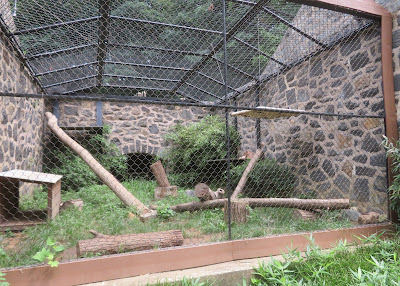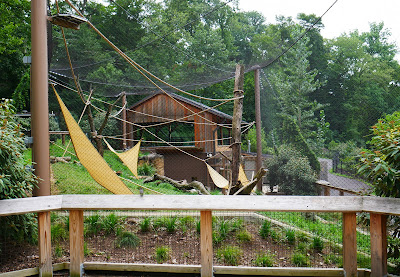In my life I have taken a complete 180 on the idea of Zoos. I used to think they were relics of paternalistic paradigms: "man's" dominion over the natural world. No doubt, that may have been part of the ethos in their inception. It is not where good zoos reside today. Modern zoos prioritize animal care, guest education and conservation, and above all species survival. Dozens of animals would be extinct today, without the intervention and research/discovery of accredited zoos.
As you know, I volunteer at the Maryland Zoo in Baltimore. I love the Maryland Zoo, but I'm poly-amorous, too, with a soft spot for little zoos. Among them, I hold in high esteem: The Sequoia Park Zoo in Eureka, CA, the Superior Zoo in Duluth, MN, the Buttonwood Park Zoo in New Bedford, MA and the Brandywine Zoo in Wilmington, DE. Fortunately, Wilmington, DE is an easy day trip!
Brandywine is an old zoo. It was founded in 1911 on the slope of the flood plain of the Brandywine River in the heart of Wilmington, DE. Its placement was the result of a decision made by the founding father of urban park design, Frederick Law Olmsted, who designed the rest of the riverside park. Because of its location, it is necessarily small, just under 5 acres. This has both positive and negative implications, and it's been a joy to watch how the zoo has capitalized on the positives over the past 20 years.
Recognizing how precious the real estate is, it has chosen to pursue excellence over abundance. You'll not see some impossible to believe statement of the number of species, there are about 30-35 on public view at any given time. It's doable in an hour or so with space for a picnic lunch to cap it off. With renovation plans on going, the zoo sports a new 3.5 million dollar multi-species habitat for 3 endangered species of Lemurs, along with tortoises and ground fowl. They have a new million dollar animal care facility. Upgrades to all of its habitats with the introduction of several new species: Red Pandas, Toco Toucans, Southern Pudu, Binturong, and Giant Anteaters--along with the Ring-tailed, Crowned, and White and Black Lemurs. And the future is bright. From my recent visit.
The Current Entrance
Master Plan drawings of a new Entrance Plaza with habitat for Flamingos, and the zoo's Southern Pudu and Sloth.
Across from the entrance is this large banner featuring a life-sized image of the Delaware state dinosaur: Dryptosaurus Aquilunguis
The first habitat you encounter is home to a pair of Andean Condors.
The male is distinguishable by his pink/reddish head.
Next on the path is the home of the zoo's Bobcat.
A longtime resident, she spends her middays napping away on a little bed at the farthest end of her habitat. "Squeakers" is a Florida Bobcat, which is a smaller sub-species.
The middle of the zoo from left to right on the hill side a visitor will encounter
1) A Honey Bee Hive and themed plaza with a colony of Italian Honey Bees
2) A trio of enclosures that date back to the depression era WPA projects, and
3) A pair of smaller habitats home to lesser primates from South America: Golden Lion Tamarinds and White-faced Saki Monkeys
On the opposite side is a little amphitheater and...
an outdoor classroom where ad hoc presentations of Ambassador animals like the zoo's Nine-banded Armadillo, Magnolia, can be staged.
Focusing our attention on the three WPA era habitats, the first one is home to the zoo's pair of Red Panda's, Sherman and Scarlet. Sherman is the zoo's third, and Scarlet is its fifth Red Panda. The pairing is determined by the AZA and it's Species Survival Program in hopes of making a positive love connection.
The two were involved in a guest experience where members of one family were getting to feed the Red Pandas.

Scarlet enjoys a little bite while Sherman watches from a distance.
Scarlet had a much whiter face.
Where Sherman's face and forehead are oranger.

Sherman engaging in some post-excitement siesta-ing!
The middle habitat was home to the zoo's Serval, Savannah, for over 13 years. Her passing allowed for a transition to another member of the wild feline community: a Caracal.

The final habitat is home to another relatively new species at the zoo, a pair of Binturong siblings, Zulla and Bintang who were born at the Potter Park Zoo in Lansing, MI back in 2022.

The far end of the zoo is a plaza with habitats all around it. The first is a pair that are home to multiple species; never quite sure what you will find there. At one time the smaller space on the left was home to Burrowing Owls.
Today it was inhabited by one of the two Toco Toucans.
The second Toco was in the larger area with a couple of little tortoises. Sometimes the Southern Pudu are out and about in this space, too. But not today.
A Red-footed Tortoise, (one of the three species of Turtles that can be found at the Brandywine Zoo)
The little guy really had someplace to go--or he was hellbent on getting his "steps" in for the day!
The crown jewel of the zoo is its relatively new 3.5 million dollar Madagascar habitat. It is home to three species of Lemur, Helmeted Guinea Fowl and Radiated Tortoises.
Two of the three White and Black Lemurs chilling in the muggy midday warmth.
The third member was engaged in a "high wire" act....
...that led to a high perch, and
zonking out with a little more privacy.
The four Ring-tailed Lemurs were all over one another near the large observational window like a cluster of puppies.
The eventually moved over to claim the space being used by the White and Blacks.
Another large habitat on the far end of the zoo is home to Scarlet Ibis, White-faced Whistling Ducks and the newest member of the zoo, a Giant Anteater, Lancaster--a.k.a. "Lants."
Another major change to he zoo in recent years was the removal of the zoo's popular, but aging River Otter habitat in favor of an expanded interactive goat corral. A new Otter habitat is in the zoo's long-range master plans, but repairing the old one was simply cost prohibitive.
These Nubian Goats are joined by some Nigerian Dwarf Goats and a pair of Angora Goats.













































No comments:
Post a Comment